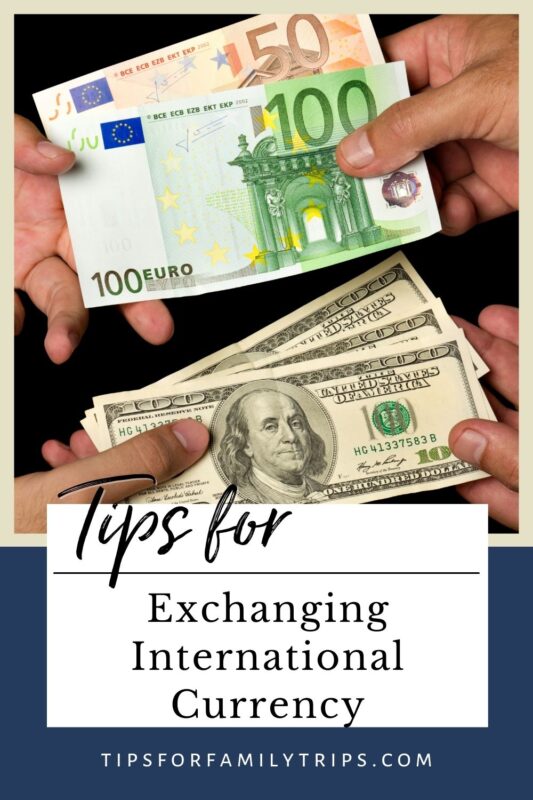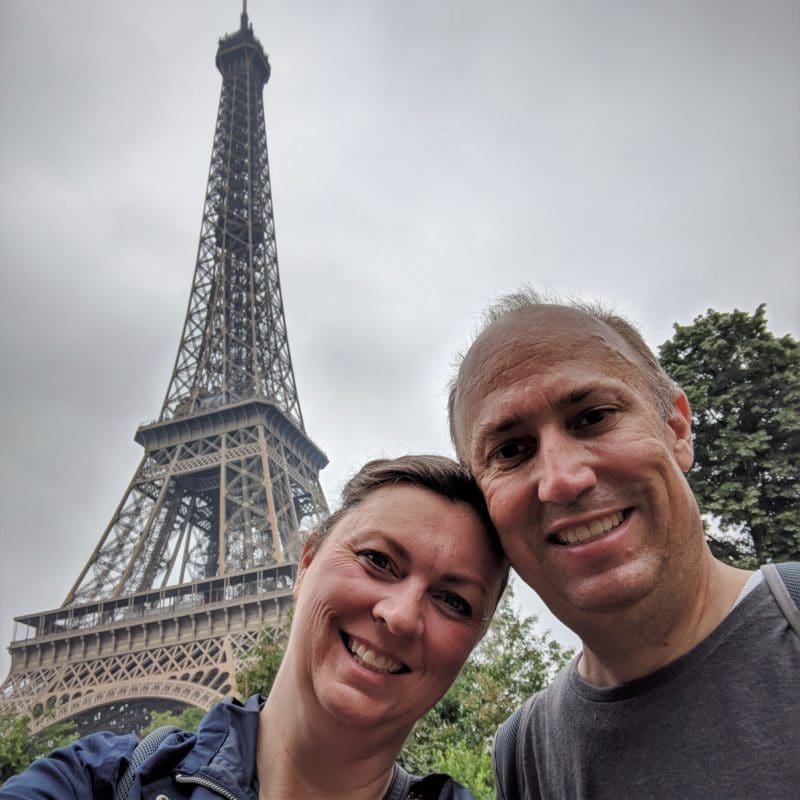Planning an international trip? How exciting! What's your plan for exchanging currency?
If you don't know where to start with foreign currency for your trip, I can help. My family has traveled to several countries, including England, France, Mexico, and Canada. And we will soon add Japan to the list.
Honestly, exchanging foreign currency is kind of a hassle – and every option has potential fees attached. But checking another bucket list destination off our list is always worth it.
And there are several ways to make exchanging currency easier and less expensive.
Here are my top tips for exchanging currency for your international trip.

Use a credit card instead
Visa and Mastercard will get the best available exchange rate every time, so use a credit card whenever you can. Bring at least two credit cards, including one Visa or MasterCard. You always need a backup card.
Make sure your credit card doesn't charge international transaction fees. This will be listed among your card's benefits. No Foreign Transaction Fees is a common benefit for travel rewards cards.
If your current credit cards charge foreign transaction fees, consider applying for a new credit card that doesn't charge fees a month or two before your trip.
How much foreign currency do you need?
I usually exchange $200-500 at my bank before a 2-week international trip. But I may get less ($50-100) for future trips when credit cards are widely accepted and low-fee ATMs are readily available at our destination.
You could just take U.S. dollars for emergencies and then rely on credit cards and ATMs for local currency when you get there. It's a good idea to travel with U.S. dollars no matter where you go. You may not spend them, but they will probably be helpful in an emergency.
How much cash you need depends on
- where you are going
- what you are doing
- how long you will be there
- how easy it will be to get more cash if you need it
The answers to these questions will become clearer as you research your destination and plan your trip. Here are a few examples.
For our trip to London and Paris, I exchanged about $200 each in pounds sterling and euros. Credit cards are widely accepted in both cities and we didn't need that much cash. So, I spent the remaining cash instead of using a credit card at the end of our stay so I didn't have to bring it home.
We learned as we researched our trip to Japan that many businesses – and public transportation! – are still cash-based. We also learned that American credit cards don't always work in Japan, but ATM machines are easy to find at 7-11 convenience stores. So we exchanged $500 for yen before the trip and opened an online fee-free checking account at CapitalOne to limit foreign ATM fees.
We often pay with U.S. dollars when we cruise from U.S. ports. There's no need to get local currency when you are only visiting for a few hours – though I usually get pesos for Mexican ports because they are so easy to get. Businesses that serve cruise passengers are usually happy to accept U.S. credit cards and dollars.
Taking a tour? Get enough foreign currency to pay a tip (usually 10-20% of the tour cost), if tipping is customary at your destination.
Get foreign currency at your bank
There are two big advantages to exchanging currency at your bank or credit union a few weeks before you leave home:
- You'll get a better exchange rate than at an airport kiosk
- It's one less thing to worry about when you arrive
The disadvantages to using your bank are that it may offer a worse exchange rate than an ATM machine and it's hard to know how much cash you'll really need.
Find out a month or two before your trip whether your local bank has the currency you need. If not, order the currency or plan to visit a branch that has your currency. You might pay an extra shipping fee if you order the currency.
If you have accounts at multiple banks, you may want to shop around. Find out which has the best rates and lowest fees for foreign currency.
I bank at a large, Utah-based bank. My usual branch doesn't have ANY foreign currency, but I can drive 15 minutes to a branch that has pesos, pounds sterling, euros, and Canadian dollars on hand. For Japanese yen, I had to drive to Salt Lake City or Provo to avoid a $25 shipping fee and hope that they had what I needed on hand (they did). For less-common currencies, I would need to pay the fee and order it.
When we planned a spring break trip to Mexico, my bank didn't have enough pesos on hand. I took what they had and went back the next week to get more. This is another reason to get your currency a few weeks before your trip.
Pack your ATM card
ATM machines will be available in most international cities and airports, so pack your debit card.
You may be charged fees by both the ATM and your bank if you withdraw cash from an out-of-network ATM. However, you may get a better exchange rate at an ATM than at your bank, so it may be your best option if the fees are low.
Avoid using your credit card for cash advances at an ATM. You'll pay too much for the convenience. Multi-currency ATM machines may not offer good exchange rates either.
When we booked an all-day tour during a Caribbean cruise, we didn't have enough cash left to pay a tip. So we used an ATM machine on the cruise ship. We paid about $8 in fees to get the cash we needed – in U.S. dollars.
We expected to need more cash in Japan than we did in Europe. Before our trip, I opened a checking account at CapitalOne, which charges no foreign ATM fees. And ATMs at 7-11 stores (which are on practically every block in Tokyo) give a good exchange rate without fees. So, we got less cash from our bank than we thought we might need.
Use local currency when you can
There are many businesses outside the U.S. that will accept U.S. dollars – but they'll charge you extra for the convenience.
Sometimes that convenience is worth it. If you're only in the country for a few hours, it might be worth paying extra instead of exchanging currency. Cruises are a good example of this. The price of everything at a cruise port goes up as soon as the ship pulls in, so convenience fees are part of the package.
Using a credit card with no foreign transaction fees anytime you can. You'll get the best available exchange rate and convenience at the same time.
What if I come home with currency?
You can exchange paper money at your bank and get U.S. dollars back at the current exchange rate. So, while you don't want to carry around cash you don't need, it's not a big loss if you get more than you spend.
Your bank will probably not exchange foreign coins, so spend them before the end of your trip or keep them as souvenirs. Your bank may not take less-common currencies you got from an ATM either. The airport kiosk might be your only option for that leftover cash.
Don't get traveler's checks
Traveler's checks are SO last-century and they will be a hassle. Use credit cards, ATMs, or get foreign currency from your bank before you leave home.
If you are worried about your cash being stolen, here are a few tips to discourage thieves:
- Split your cash with your spouse or teens. If a purse or wallet is stolen, you won't lose all your cash.
- Keep most of your cash in your hotel room safe. Restock your wallet as needed.
- Use a travel purse, neck wallet, or money belt that is designed to make your cash difficult to steal.
- Don't show all your cash. Organize it so you don't have to pull out a big wad of bills to make a purchase.
- Leave jewelry and other obviously-expensive items at home. They will draw the attention of thieves.
My father-in-law's wallet was stolen from his back pocket when he visited Italy last year. He had a neck wallet and his passport stayed safe there, but he lost all his cash and everything else in his regular wallet.
Thieves look for easy opportunities – like wallets in open back pockets. There is no need to be fearful, but it's smart to plan ahead to keep your cash safe when you travel.

Conclusion
Use these tips to get the best exchange rates on foreign currency for your international trip – with minimum hassle.
And give yourself some grace. It's OK if you pay a convenience fee here or there because we are not talking about a large amount of money. But when you know where the fees hide, you can avoid them more often and spend that money on a fun activity or delicious meal instead.
I hope that our experience helps your family to plan a great international trip! Do you have a question, travel tip, or experience to share? Please use the Comments below.
Happy travels!













Have a question or comment? Add it here.